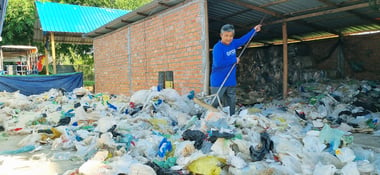
Tamara Davison
Tamara Davison is a journalist who specializes in sustainability and the environment. Reporting from around the world, she's seen firsthand the direct impact waste is having on coastal communities and our oceans. As a diver trained in ecological monitoring, the changes Tamara has seen in marine habitats inspired her to action. She's previously written for The Guardian, The Independent and the Evening Standard. She's also produced environmental documentaries for EuroNews.
In early 2024, scientists discovered an average of 240,000 pieces of tiny plastic in each liter of bottled water.
The study, published in the Proceedings of the National Academy of Sciences, added that 90% of the particles were nanoplastics, which previous research may have missed.
We now know that microplastics exist in practically every aspect of human life — and within the human body itself.
While scientists need more time to understand the impacts on our health, initial findings suggest microplastics pose a serious issue to humans that might become more severe in the future.
It might feel impossible to avoid microplastics altogether, but you can start by controlling the amount of harmful particles you encounter daily — and here’s how.
What’s on this page?
01 | Top 7 products to ditch to avoid microplastics
02 | Summary
03 | FAQs
Top 7 products to ditch to avoid microplastics
More people are becoming aware of microplastics as more research gets published. And while this might have put many people off more obvious products, like plastic water bottles, there are a number of other products you should avoid.
We've listed the top products to ditch below.
1. Plastic cutting boards
In 2023, researchers found that plastic chopping boards were a significant source of microplastic contamination.
The report concluded that chopping boards alone could expose humans to up to 79.4 million polypropylene (a type of plastic polymer) microplastics each year.
While results varied depending on the type of plastic used, researchers discovered that cutting vegetables (like carrots, which were used as an example in the study) increased the transfer of microplastics to the food.
Earlier studies also found similar results, suggesting that chopping boards can also contaminate other food products, like meat.
Eliminating direct contact between plastic kitchenware and food ingredients could help reduce the amount of microplastics you are exposed to.
Alternatives to try
Tempered glass chopping boards are a relatively inexpensive alternative that’s easy to clean and doesn’t usually contain microplastics. The sustainable UK brand Smidge also stocks a collection of plastic-free chopping boards made from paper fibers that are just as durable.

2. Microwavable food containers
While microwavable plastic containers are suitable for storing food and preventing contamination, they’re also a significant source of microplastic contamination.
Multiple studies have found that hard microwavable plastic products, such as Tupperware and plastic packaging considered ‘microwave safe,’ release staggering amounts of microplastics into food, especially when microwaved due to heat and chemical reactions.
One of the most shocking findings came from a 2023 study by researchers at the University of Nebraska, Lincoln. They investigated various baby food products that came in ‘safe’ plastic packaging and discovered up to 4 million microplastics released in every square centimeter of some plastic packaging.
When they put the microplastics under the microscope, scientists found the particles killed up to 75% of cultured kidney cells they came into contact with, suggesting there may be a connection between microplastics and the health of human cells.
Alternatives to try
But what’s the solution? Ceramic and glass containers are usually microwave-friendly and don’t leak microplastics.
A paper from The American Academy of Pediatrics also suggested prioritizing fresh fruit and vegetables, avoiding processed food, and specifically avoiding products wrapped in phthalates, styrene, and bisphenols (types of polymers and chemicals linked to various plastics).
3. Ice cubes
Given the prevalence of microplastics in bottled water, it should unfortunately come as no surprise that other water products have similar levels of contamination.
In 2023, researchers found that 100% of pre-packaged ice cubes across 15 brands in Mexico contained microplastic contamination. Results varied, but the most prevalent microplastics were polypropylene, polyethylene, and polyvinyl alcohol.
When you turn to DIY ice cube trays, there’s even less research. However, an associate professor told HealthCentral that freezing plastic can also cause microplastics to leach into water; much like heating does.
Alternatives to try
Over the last few years, a more sustainable solution has emerged. Stainless steel ice cube trays are a healthier alternative that looks good at dinner parties and is, in fact, easier to use.
Silicone ice cube trays have similarly been touted as a sustainable alternative that some believe is better for human health and is easier to remove ice from.
4. Paper cups
Yep, you read that right — paper cups can actually produce a lot of microplastics.
While paper cups may seem better for the environment, they’re an unlikely source of plastic pollution. Paper cups need a layer of sealant to hold liquids inside, so they often consist of up to 10% high-density polyethylene (HDPE).
HDPE makes recycling paper cups challenging because they need to be separated from paper in order to be recycled — which, as you’ve probably gathered, isn’t that easy. and can cause microplastic contamination when used for hot drinks. In 2021, a study found that hot temperatures release other chemicals, including fluoride, chloride, sulfate, and nitrate.
Alternatives to try
Opting for a reusable stainless steel flask is better for the planet and reduces your exposure to microplastics.
People now commonly switch disposable paper cups for reusable flasks or bottles (see our guide to the best sustainable bottles here). Some coffee shops even reward customers who bring in refillable cups, encouraging shoppers to think about the planet when ordering their coffee.
5. Tea bags
Although this might surprise a lot of people, many tea bags are made with unsustainable polypropylene plastic — and even paper tea bags can have traces of plastic in the sealant.
This means many tea bags aren’t biodegradable and may lead to microplastic contamination.
In 2023, researchers raised concerns about how hot water used to brew tea impacts tea bags and releases millions of microplastics. Titled “a truly global problem,” scientists concluded that one cup of tea contained up to 3.1 billion nanoplastics due to the tea bag.
The study also noted that tea bags could contain other harmful substances, such as “fluorine compounds, arsenic, radium salt, aluminum, copper, lead, mercury, cadmium, barium, and nitrates.”
Very few studies have examined the health risks of microplastics linked to tea bags. Luckily, loose tea leaves are regaining popularity, and there are plenty of sustainable tea brewing alternatives, such as a cast-iron teapot or a metal strainer. The Plastic Pollution Coalition even suggested using cotton tea bags or straining your drinking through organic linen.

6. Synthetic makeup
In 2022, Plastic Soup discovered that just 13% of the 7,000 beauty products they analyzed were free from microplastics. Although there have been many promising developments in the clean beauty field, an alarming number of beauty products and cosmetics contain harmful microplastic ingredients.
A lot of these particles are primary microplastics, that are deliberately added to cosmetics like microbeads in exfoliants. Few studies have looked at secondary microplastics that may leak from the packaging into cosmetics themselves.
Microplastics in products can negatively impact your skin. Although more research is needed, some studies have found that microplastics can lead to inflammation, irritation, and the disruption of natural skin functions.
Alternatives to try
Unfortunately, it's difficult to avoid microplastics and chemicals in cosmetics and body care products altogether, but a growing sustainable movement is helping to improve accessibility to kind-to-skin products.
Purchasing products that focus on natural ingredients and plastic-free packaging is the best way to limit your skin’s contact with microplastics through cosmetics. Support brands that offer glass refill programs and look for ethically sourced and natural ingredients, like plant extracts.
CleanHub recently conducted a Clean Beuty survey on sustainable cosmetic trends. Discover more about what we found here.
7. Polyester clothing
Almost 33% of dust found within a typical home consists of microplastics derived from textiles. Synthetic clothing made from polyester, polyamide, and nylon can shed, leaving microplastic traces in the air, skin, and water supplies.
Washing synthetic clothing leads to even more alarming results. Researchers discovered that a single load of laundry can release up to 1.5 million synthetic microfibers into waterways, most of which will pollute our environment.
In fact, researchers believe that synthetic textiles contribute the most microplastic pollution to our oceans, accounting for up to 35%.
Alternatives to try
You can reduce the amount of microplastics in your home and laundry by opting for natural fiber clothing made from cotton or hemp. Regularly hoovering and mopping will also help mitigate the microplastics in your home.
Summary
Trying to avoid microplastics can sometimes feel hopeless. We live in a plastic world, and our reliance on plastic products can be hard to avoid.
From watch straps to pillowcases, tiny plastic particles have been detected in every corner of our homes — and in many cases, there is no labeling or information on products to tell you this.
But there is a glimmer of hope. A number of technologies have started to address plastic pollution, including microplastics.
Brands are increasingly starting to listen to conscious consumers who invest in products that are kind to the planet and free from plastic.
Governments are also putting more pressure on businesses (through things like the Global Plastics Treaty) to do their bit to combat harmful plastics.
Awareness about the prevalence of microplastics can be used as an inspiration for action. Knowing what items expose you to microplastics empowers you to influence real change — and that’s something to feel hopeful about.
FAQs
How can we prevent microplastics in daily life?
While avoiding microplastics in everyday life may feel challenging, little adjustments to how you consume food and clean your clothes can go a long way. The best way to prevent microplastics is to cut out plastic materials and use natural, alternative materials.
How can we reduce microplastics?
Several studies are currently exploring ways to reduce and collect microplastics that pollute our environment. You can reduce microplastics by leveraging water filters, cutting out single-use plastic, and ditching products that contain microbeads and synthetic materials.
Why avoid microplastics?
We’ve known for a while that microplastics can enter and travel around the human body. Scientists are reluctant to say this poses a negative challenge to human health, as it's probably too soon to tell. But, early studies have found microplastics can alter cells and change their function.

-1.webp)
.webp?width=380&name=Sarah-Jeanne-Royer%20(1).webp)

.jpg?width=380&name=Microplastics%20in%20hands%20(1).jpg)






.jpg?width=380&name=drone-2021-12-06-10h31m38s177%20(1).jpg)
